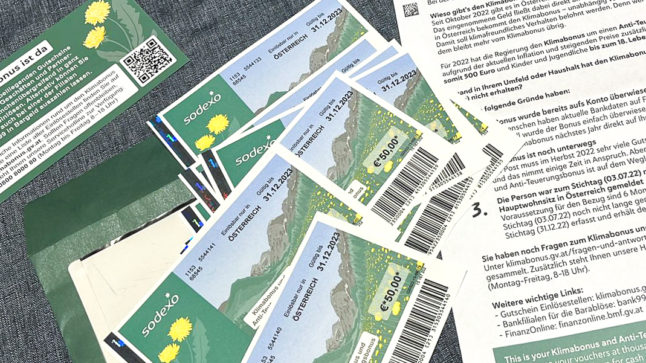As energy prices continue to rise following Russia’s invasion of Ukraine and the subsequent economic sanctions imposed by western countries, there are concerns about the impact on domestic economies in Europe.
A recent report by the Austrian Institute of Economic Research (WIFO) states Austria is most at risk in relation to its energy supplies, with Russian natural gas imports accounting for more than three quarters of Austria’s entire gas supply.
Some Austrian banks are also impacted by sanctions against Russia due to high credit claims by Russian customers.
What does this mean for Austria’s economy? And how could an escalation of the conflict or new sanctions further impact Austria?
READ MORE: How reliant is Austria on Russia for energy?
Energy
On Tuesday (March 8th), Russian Deputy Prime Minister Alexander Novak threatened to stop the supply of Russian gas to Europe as western nations considered escalating sanctions against Russia, including a ban on Russian oil imports.
According to British newspaper The Guardian, Novak made the threat in connection to Germany’s decision last month to halt the certification of the Nord Stream 2 pipeline.
Novak said: “We have every right to take a matching decision and impose an embargo on gas pumping through the Nord Stream 1 gas pipeline.”
Austria currently sources 80 percent of its natural gas from Russia. An interruption to gas imports would be acutely felt in the alpine republic and could even impact the chemical, fertiliser, pharmaceutical and plastic industries.
In this scenario, WIFO anticipates there would be gas shortages in the country by late autumn, although Austria could source alternative supplies from other countries.
READ MORE: EXPLAINED: Why isn’t Austria in NATO?
However, WIFO estimates that Austria’s economy could be hit harder by restrictions on gas than the EU average, with a potential 1.25 percent loss on overall economic value added (estimate of economic profit). The average EU loss is predicted to be 0.7 percent.
The report states: “The risks are therefore considerable and could unfold a significant negative impact on economic development.”
In the short term, energy prices are already rising following the announcement of economic sanctions imposed on Russia by the EU, UK and USA on February 22nd.
Gas prices could rise even further if the conflict in Ukraine intensifies with the possibility of a 50 percent increase in energy prices compared to the fourth quarter of 2021.
But WIFO also sees the potential for rapid restructuring of the supply of energy in Europe, albeit with significant investment.
The report states: “One can therefore see the energy crisis provoked by Russia as an opportunity to push ahead with the restructuring of the European energy system much faster and much more than previously planned. International cooperation is essential for the success of such a project.”
Banking
The economists behind the WIFO report have ranked Austria as the most affected country in western economies when it comes to the impact of sanctions on banks.
This is due to high credit claims by Russian customers in Austrian banks. Raiffeisen is particularly affected and Reuters reports that the bank is considering leaving Russia.
READ ALSO: Nehammer on Russian sanctions: ‘Austria is and will remain neutral’
In fact, Austria ranks third in the amount of money outstanding by Russian customers at almost €18 billion. Only banks in France and Italy have been hit harder with both countries recording outstanding credit of more than €25 billion.
Despite the large amounts, WIFO says the situation is unlikely to cause systematic damage to Austria’s domestic banking system. Instead, the analysts expect the Russian financial sector to be impacted more than Austria or other EU countries.
For example, Austrian investments in Russia currently total around €4.6 billion, but Russian investments in Austria are approximately €21.4 billion.
Food
Ukraine is one of the world’s largest exporters of wheat, which means grocery prices are set to rise in Austria, according to Der Standard. This will especially impact products like bread and pastries.
The Kronen Zeitung reports that both Russia and Ukraine are also big producers and exporters of corn (30 percent and 20 percent respectively), so the price of corn will rise.
Additionally, the conflict is expected to impact already constrained supply chains for other products (including agricultural parts and machinery), as well as affect supplies of ammonia for fertiliser, which is obtained from natural gas.
This will further raise the cost of food in supermarkets.
FOR MEMBERS: UPDATED: How Austria could be impacted by the war in Ukraine
Trade
Trade flows between Austria and Ukraine total around €90 million and the most damaging impact could be an interruption in the import of oil crops. Rapeseed is of particular importance for Austria as it is used for the production of biofuels.
Ukraine is also one of the largest exporters of rapeseed in Europe and, prior to Russia’s invasion, was anticipating one of the most profitable winter crops after favourable autumn weather conditions.
Elisabeth Christen, Senior Economist at WIFO, told The Local that trade flows between Austria and Russia are not as high with just 1.5 percent of imports and 1.5 percent of exports flowing between the two countries. This amounts to €2.2 billion in trade.



 Please whitelist us to continue reading.
Please whitelist us to continue reading.
Member comments